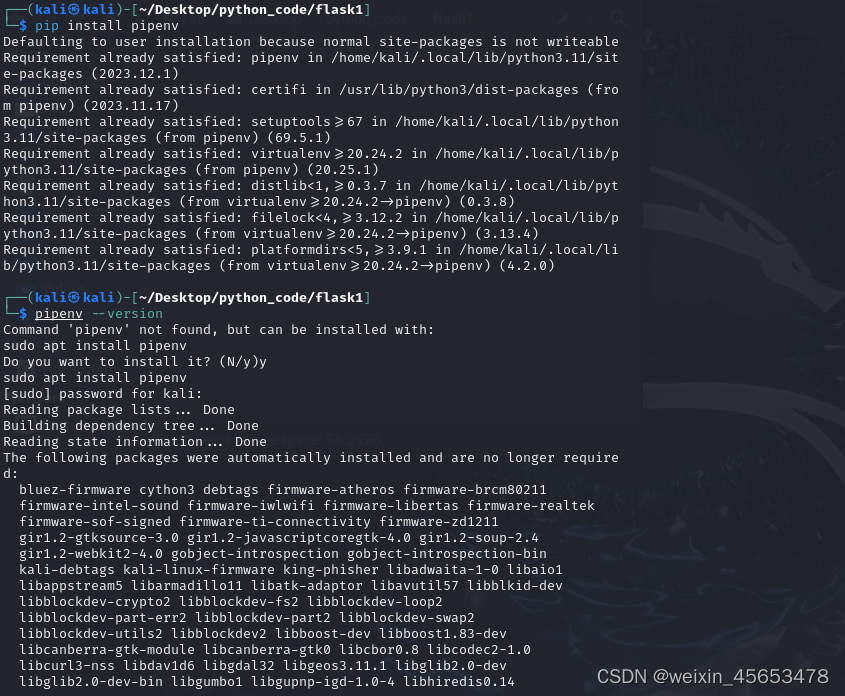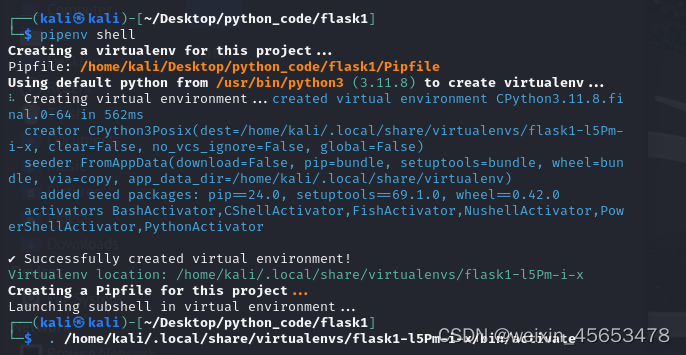1 flask介绍
Flask是一个非常小的Python Web框架,被称为微型框架;只提供了一个稳健的核心,其他功能全部是通过扩展实现的;意思就是我们可以根据项目的需要量身定制,也意味着我们需要学习各种扩展库的使用。
2 python虚拟环境搭建
python虚拟环境管理方法: 1.virtualenv 2.Virtualenvwrapper 3.conda 4.pipenv

3 pipenv使用
┌──(kali㉿kali)-[~/Desktop/python_code] └─$ ls flask1 ┌──(kali㉿kali)-[~/Desktop/python_code] └─$ cd flask1 ┌──(kali㉿kali)-[~/Desktop/python_code/flask1] └─$ pipenv shell

┌──(flask1-l5Pm-i-x)─(kali㉿kali)-[~/Desktop/python_code/flask1] └─$ ls Pipfile #Pipfile 等于安装的插件包名 ┌──(flask1-l5Pm-i-x)─(kali㉿kali)-[~/Desktop/python_code/flask1] └─$ cat Pipfile 安装 flask ┌──(flask1-l5Pm-i-x)─(kali㉿kali)-[~/Desktop/python_code/flask1] └─$ pipenv install flask
4 flask第一个应用
新建app.py
#!/usr/bin/env python3
from flask import Flask
#初始化
app =Flask(__name__)
@app.route('/')
def index():
return 'Hello World!'
if __name__ == '__main__':
app.run()
执行app.py

游览器效果

5 路由和视图函数
#!/usr/bin/env python3
# 这一行告诉系统使用哪个解释器来执行脚本,这里指定为 python3
from flask import Flask
# 从flask模块中导入Flask类,用于创建Flask web应用程序实例
# 初始化
app = Flask(__name__)
# 创建一个Flask应用程序实例,并赋值给变量app。__name__是当前模块的名字,代表应用程序的根路径
# 设置多个路由
@app.route('/')
# 定义一个路由装饰器,当访问根路径'/'时,会调用下面的index函数
def index():
return 'Hello World!'
# 定义一个视图函数index,当访问'/'路径时,返回'Hello World!'字符串
@app.route('/a')
# 定义另一个路由装饰器,当访问'/a'路径时,会调用下面的add函数
def add():
return '1+1=2'
# 定义一个视图函数add,当访问'/a'路径时,返回'1+1=2'字符串
@app.route('/user/<username>')
# 定义一个带有动态部分的路由装饰器,'<username>'是一个动态部分,可以匹配任何字符串
def user_index(username):
# 在函数中指明变量名称username,就能获取到通过路由传入的变量username
return 'Hello {} '.format(username)
# 定义一个视图函数user_index,该函数接受一个参数username,这是从路由动态部分获取的。函数返回'Hello '加上用户名
@app.route('/post/<int:post_id>')
# 定义一个带有动态部分且类型指定的路由装饰器,'<int:post_id>'表示动态部分必须是整数类型
def show_post(post_id):
return 'Post {} '.format(post_id)
# 定义一个视图函数show_post,该函数接受一个整数类型的参数post_id,这是从路由动态部分获取的。函数返回'Post '加上文章ID
if __name__ == '__main__':
# 判断当前脚本是否作为主程序运行
app.run(debug=True)
6URL重定向
#!/usr/bin/env python3
# 导入 Flask 框架
from flask import Flask
from flask import url_for
from flask import redirect
# 初始化 Flask 应用
app = Flask(__name__)
# 设置路由到根路径 '/'
@app.route('/')
def index():
return 'Hello World!' # 返回欢迎信息
# 设置路由到 '/a'
@app.route('/a')
def add():
return '1+1=2' # 返回加法运算结果
# 设置路由到 '/user/<username>',其中 <username> 是一个动态部分
@app.route('/user/<username>')
def user_index(username):
# 在视图函数中通过参数获取路由中的动态部分 username
return 'Hello {} '.format(username) # 返回包含用户名的欢迎信息
# 设置路由到 '/post/<int:post_id>',其中 <int:post_id> 是一个整数类型的动态部分
@app.route('/post/<int:post_id>')
def show_post(post_id):
return 'Post {} '.format(post_id) # 返回包含帖子ID的字符串
# 设置路由到 '/test'
@app.route('/test')
def test():
# 使用 url_for 函数生成路由的 URL,并打印出来
print(url_for('index')) # 打印根路径的 URL
print(url_for('user_index', username='scj')) # 打印用户路径的 URL,传入用户名 'scj'
print(url_for('show_post', post_id=1)) # 打印帖子路径的 URL,传入帖子ID 1
return 'test' # 返回测试字符串
# 设置路由到 '/<username>',其中 <username> 是一个动态部分
@app.route('/<username>')
def hello(username):
if username == 'handsomescj':
return 'Hello {}' .format(username) # 如果用户名是 'handsomescj',则返回欢迎信息
else:
return redirect(url_for('index')) # 否则重定向到根路径
# 主程序入口
if __name__ == '__main__':
app.run(debug=True) # 运行 Flask 应用,并开启调试模式
请注意,代码中有个小的错误,app =Flask(__name__) 这一行应该去掉变量名 app 前的空格,修改为 app = Flask(__name__)。
在 Flask 应用中,注释是一个很好的习惯,它们可以帮助你和其他开发者理解代码的功能和逻辑。在编写代码时,记得添加足够的注释,尤其是在复杂的逻辑部分。
7模板渲染
python
#!/usr/bin/env python3
# 导入 Flask 框架
from flask import Flask
from flask import url_for
from flask import redirect
from flask import render_template
# 初始化 Flask 应用
app = Flask(__name__)
# 设置路由到根路径 '/'
@app.route('/')
def index():
return 'Hello World!' # 返回欢迎信息
# 设置路由到 '/a'
@app.route('/a')
def add():
return '1+1=2' # 返回加法运算结果
# 设置路由到 '/user/<username>',其中 <username> 是一个动态部分
@app.route('/user/<username>')
def user_index(username):
# 使用 render_template 函数渲染 'user_index.html' 模板,并传入变量 username
return render_template('user_index.html', username=username) # 返回渲染后的页面
# 设置路由到 '/post/<int:post_id>',其中 <int:post_id> 是一个整数类型的动态部分
@app.route('/post/<int:post_id>')
def show_post(post_id):
return 'Post {} '.format(post_id) # 返回包含帖子ID的字符串
# 设置路由到 '/test'
@app.route('/test')
def test():
# 使用 url_for 函数生成路由的 URL,并打印出来
print(url_for('index')) # 打印根路径的 URL
print(url_for('user_index', username='scj')) # 打印用户路径的 URL,传入用户名 'scj'
print(url_for('show_post', post_id=1)) # 打印帖子路径的 URL,传入帖子ID 1
return 'test' # 返回测试字符串
# 设置路由到 '/<username>',其中 <username> 是一个动态部分
@app.route('/<username>')
def hello(username):
if username == 'handsomescj':
return 'Hello {}' .format(username) # 如果用户名是 'handsomescj',则返回欢迎信息
else:
return redirect(url_for('index')) # 否则重定向到根路径
# 主程序入口
if __name__ == '__main__':
app.run(debug=True) # 运行 Flask 应用,并开启调试模式
新建templates 文件夹
以及在templates 文件中新建user_index.html
<h1>hello,{{ username }}!</h1>
8 get与post请求
get请求
#!/usr/bin/env python3
from flask import Flask
from flask import url_for
from flask import redirect
from flask import render_template
#初始化
app =Flask(__name__)
#设置多个路由
@app.route('/')
def index():
return 'Hello World!'
@app.route('/a')
def add():
return '1+1=2'
@app.route('/user/<username>')
def user_index(username):
#在函数中指明变量名称username,就能获取到通过路由传入的变量username
return render_template('user_index.html',username=username)
@app.route(' /user/<password>' )
def user_password(password) :
print( 'User-Agent :' , request.headers.get ( 'User-Agent ' ))
print( 'time: ' , request.args. get( 'time'))
print( 'q: ' , request.args. get( 'q'))
print ( 'issinge : ' , request.args.get( ' issinge ' ))
return ' password is{} '.format(password)
@app.route('/post/<int:post_id>')
def show_post(post_id):
return 'Post {} '.format(post_id)
@app.route('/test')
def test():
print(url_for('index'))
print(url_for('user_index',username='scj'))
print(url_for('show_post',post_id=1))
return 'test'
@app.route('/<username>')
def hello(username):
if username =='handsomescj':
return 'Hello {}' .format(username)
else:
return redirect(url_for('index'))
if __name__ == '__main__':
app.run(debug=True)
post请求
#!/usr/bin/env python3
from flask import Flask, request, render_template, redirect, url_for
# 初始化
app = Flask(__name__)
# 设置多个路由
@app.route('/')
def index():
return 'Hello World!'
@app.route('/a')
def add():
return '1+1=2'
@app.route('/user/<username>')
def user_index(username):
# 在函数中指明变量名称username,就能获取到通过路由传入的变量username
return render_template('user_index.html', username=username)
@app.route('/user/<password>')
def user_password(password):
print('User-Agent:', request.headers.get('User-Agent'))
print('time:', request.args.get('time'))
print('q:', request.args.get('q'))
print('issinge:', request.args.get('issinge'))
return 'password is {}'.format(password)
@app.route('/post/<int:post_id>')
def show_post(post_id):
return 'Post {}'.format(post_id)
@app.route('/test')
def test():
print(url_for('index'))
print(url_for('user_index', username='scj'))
print(url_for('show_post', post_id=1))
return 'test'
@app.route('/<username>')
def hello(username):
if username == 'handsomescj':
return 'Hello {}'.format(username)
else:
return redirect(url_for('index'))
@app.route('/register', methods=['GET', 'POST'])
def register():
print('method:', request.method)
print('name:', request.form['name'])
print('password:', request.form.get('password'))
print('hobbies:', request.form.getlist('hobbies'))
print('age:', request.form.get('age', default=18))
return 'register success!'
if __name__ == '__main__':
app.run(debug=True)
新建client.py
#!/usr/bin/env python3
import requests
# 设置需要发送的数据
user_info = {
'name': 'scj', # 去掉键和值之间的空格
'password': '123456', # 去掉键和值之间的空格
'hobbies': ['code', 'run'] # 列表中的字符串去掉空格
}
# 向url发送post请求
r = requests.post("http://127.0.0.1:5000/register", data=user_info)
print(r.status_code) # 打印请求返回的状态码
9session与cookie
#!/usr/bin/env python3
from flask import Flask
from flask import url_for
from flask import redirect
from flask import render_template
from flask import request
from flask import session
from flask import make_response
# 初始化
app = Flask(__name__)
app.secret_key='kdjklfjkd87384hjdhjh'
# 设置多个路由
@app.route('/')
def index():
return 'Hello World!'
@app.route('/a')
def add():
return '1+1=2'
#@app.route('/user/<username>')
#def user_index(username):
# 在函数中指明变量名称username,就能获取到通过路由传入的变量username
#return render_template('user_index.html', username=username)
@app.route('/user/<password>')
def user_password(password):
print('User-Agent:', request.headers.get('User-Agent'))
print('time:', request.args.get('time'))
print('q:', request.args.get('q'))
print('issinge:', request.args.get('issinge'))
return 'password is {}'.format(password)
@app.route('/post/<int:post_id>')
def show_post(post_id):
return 'Post {}'.format(post_id)
@app.route('/test')
def test():
print(url_for('index'))
print(url_for('user_index', username='scj'))
print(url_for('show_post', post_id=1))
return 'test'
@app.route('/<username>')
def hello(username):
if username == 'handsomescj':
return 'Hello {}'.format(username)
else:
return redirect(url_for('index'))
@app.route('/register', methods=['GET', 'POST'])
def register():
print('method:', request.method)
print('name:', request.form['name'])
print('password:', request.form.get('password'))
print('hobbies:', request.form.getlist('hobbies'))
print('age:', request.form.get('age', default=18))
return 'register success!'
@app.route('/set_session')
def set_session():
# 设置session的持久化
session.permanent = True
session['username'] = 'scj'
return '成功设置session'
@app.route('/get_session')
def get_session():
value = session.get('username')
return '成功获取session值为:{}'.format(value)
@app.route('/set_cookie/<username>')
def set_cookie(username):
resp = make_response(render_template('user_index.html', username=username))
resp.set_cookie('user', username) # 使用'user'作为cookie的名字
return resp
@app.route('/get_cookie')
def get_cookie():
username = request.cookies.get('username') # 使用'user'来检索cookie的值
return 'Hello {}'.format(username) # 修正格式化字符串的语法
if __name__ == '__main__':
app.run(debug=True)
10 errot404
#!/usr/bin/env python3
from flask import Flask
from flask import url_for
from flask import redirect
from flask import render_template
from flask import request
from flask import session
from flask import make_response
# 初始化
app = Flask(__name__)
app.secret_key='kdjklfjkd87384hjdhjh'
# 设置多个路由
@app.route('/')
def index():
return 'Hello World!'
@app.route('/a')
def add():
return '1+1=2'
@app.route('/user/<username>')
def user_index(username):
if username == 'invalid'
abort(404)
return render_template('user_index.html',username=username)
@app.route('/user/<password>')
def user_password(password):
print('User-Agent:', request.headers.get('User-Agent'))
print('time:', request.args.get('time'))
print('q:', request.args.get('q'))
print('issinge:', request.args.get('issinge'))
return 'password is {}'.format(password)
@app.route('/post/<int:post_id>')
def show_post(post_id):
return 'Post {}'.format(post_id)
@app.route('/test')
def test():
print(url_for('index'))
print(url_for('user_index', username='scj'))
print(url_for('show_post', post_id=1))
return 'test'
#@app.route('/<username>')
#def hello(username):
# if username == 'handsomescj':
# return 'Hello {}'.format(username)
# else:
# return redirect(url_for('index'))
@app.route('/register', methods=['GET', 'POST'])
def register():
print('method:', request.method)
print('name:', request.form['name'])
print('password:', request.form.get('password'))
print('hobbies:', request.form.getlist('hobbies'))
print('age:', request.form.get('age', default=18))
return 'register success!'
@app.route('/set_session')
def set_session():
# 设置session的持久化
session.permanent = True
session['username'] = 'scj'
return '成功设置session'
@app.route('/get_session')
def get_session():
value = session.get('username')
return '成功获取session值为:{}'.format(value)
@app.route('/set_cookie/<username>')
def set_cookie(username):
resp = make_response(render_template('user_index.html', username=username))
resp.set_cookie('user', username) # 使用'user'作为cookie的名字
return resp
@app.route('/get_cookie')
def get_cookie():
username = request.cookies.get('username') # 使用'user'来检索cookie的值
return 'Hello {}'.format(username) # 修正格式化字符串的语法
@app.route(404)
def not_found(error):
return render_template('404.html'),404
if __name__ == '__main__':
app.run(debug=True)
404.html
错了,sb